You’ll want to focus on color saturation first—look for rich violetish-blue hues without muddy tones, as these command premium prices from $100-800 per carat. Assess clarity by ensuring the stone is eye-clean, since heat treatment doesn’t improve inclusions. Examine pleochroism by viewing the stone from different angles to see distinct blue, violet, and red color shifts. Consider carat weight carefully, as stones above 2 carats become exponentially more valuable due to scarcity. These fundamentals will guide your evaluation process effectively.
Understanding Heat Treatment’s Impact on Tanzanite Pricing
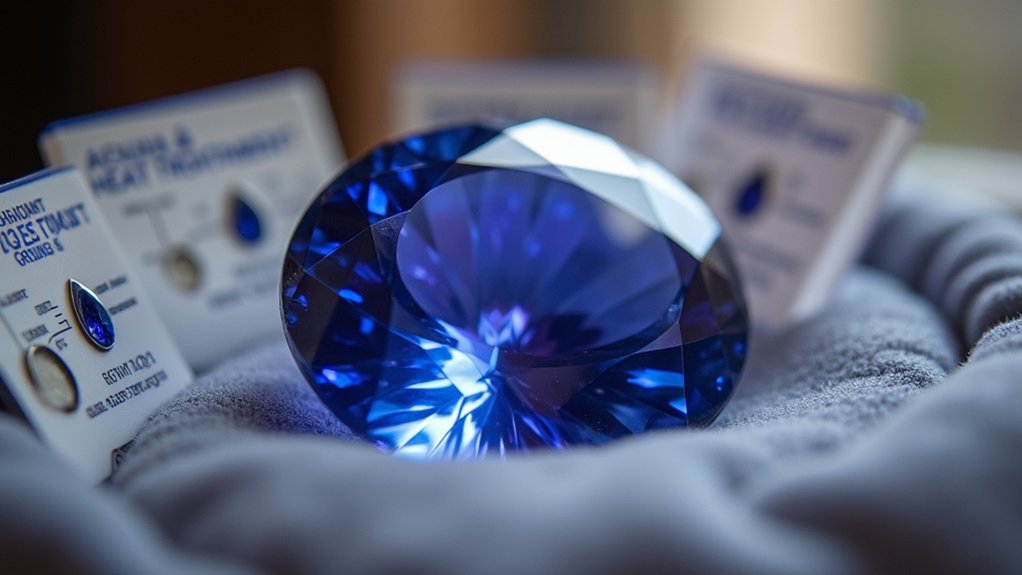
When you’re evaluating tanzanite’s worth, you’ll find that heat treatment greatly shapes pricing dynamics in today’s market.
Most tanzanite stones undergo this process to eliminate unwanted yellow and brown tones, revealing the coveted blue color that collectors prize.
However, heat treatment doesn’t automatically boost the value of Tanzanite – you’ll still need to assess the traditional 4 Cs: Color, Carat, Cut, and Clarity.
You can expect heat-treated stones to range from $100 to $800 per carat, with deeper blues commanding premium prices.
While the industry widely accepts this enhancement, you should know that rare unheated specimens with exceptional natural blue hues are considerably more valuable due to their untreated status and rarity in the marketplace.
Evaluating Color Saturation After Heat Enhancement
When you’re evaluating heat-treated tanzanite, you’ll need to assess how intensely saturated the colors appear after enhancement.
You should examine the saturation intensity levels carefully, as deeper, richer colors command higher market values than pale or washed-out stones.
Pay close attention to the blue-violet hue balance, since the most desirable tanzanites display vibrant color without one hue overpowering the other.
Saturation Intensity Levels
Although heat treatment transforms tanzanite’s appearance dramatically, you’ll find that saturation intensity varies considerably across different stones, directly impacting their market value. Understanding these intensity levels helps you make informed purchasing decisions.
| Saturation Level | Color Characteristics | Market Value |
|---|---|---|
| High Intensity | Rich violetish blue, exceptional vibrancy | Premium pricing |
| Medium Intensity | Moderate blue/violet, good saturation | Mid-range value |
| Low Intensity | Pale blue/violet, lighter tones | Lower value |
When evaluating heat treated tanzanite, you’ll notice that top-grade stones achieve deep, vivid colors with strong saturation intensity. Medium-grade specimens often display lighter saturation levels after treatment, while the most valuable pieces exhibit exceptional color quality that commands premium prices in today’s market.
Blue-Violet Hue Balance
After heat treatment enhances tanzanite’s natural properties, the blue-violet hue balance becomes the primary factor determining a stone’s desirability and market position.
You’ll want to evaluate how well the stone displays both blue and violet components, as quality tanzanite should showcase a rich saturation of these complementary hues.
When examining how the color looks after heat enhancement, focus on these key aspects:
- Balanced saturation – Look for stones where neither blue nor violet dominates completely
- Elimination of unwanted tones – Verify that yellow and brown undertones have been successfully removed
- Deep color intensity – Seek stones that achieved vivid blue-violet richness rather than pale results
Remember that medium-grade stones typically respond better to heat treatment than originally pale specimens.
Assessing Clarity Standards in Treated Tanzanite
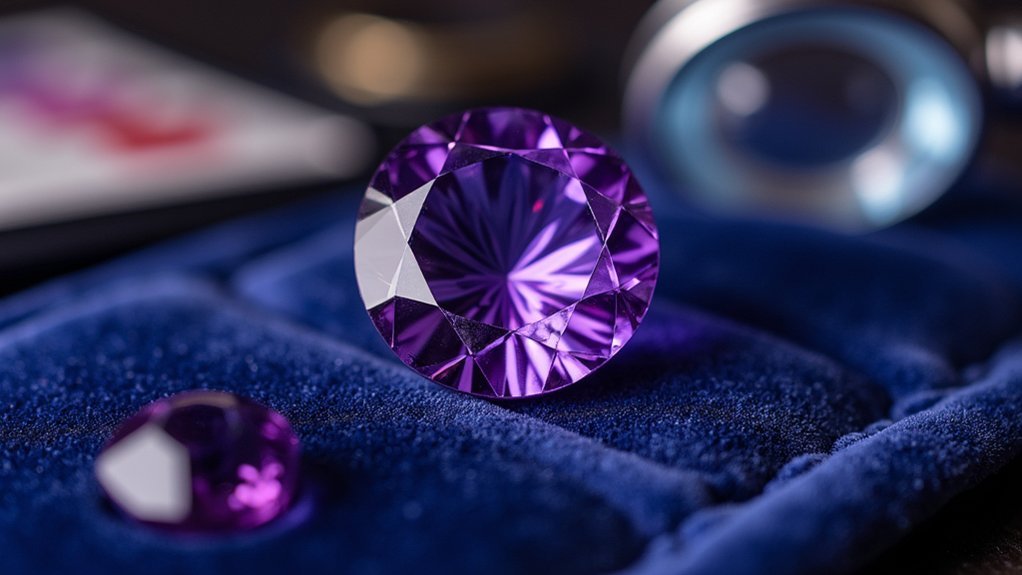
Since clarity directly affects tanzanite’s market value, you’ll need to understand how gemologists evaluate this essential characteristic in heat-treated tanzanite.
Eye-clean stones without visible inclusions command premium prices because they’re considerably more desirable. When evaluating value, remember that heat treatment doesn’t improve clarity—you’re examining the stone’s natural characteristics post-treatment.
Focus on stones with minimal inclusions, as they achieve better clarity ratings and higher market values.
Pay attention to cut quality, which greatly impacts clarity perception. A well-executed cut enhances light reflection and reduces the visibility of internal imperfections, making inclusions less noticeable.
During evaluation, examine stones under proper lighting conditions to accurately determine their clarity grade and establish fair market pricing for your heat-treated tanzanite investment.
Determining Optimal Carat Weight for Investment Value
When you’re selecting tanzanite for investment, you’ll find that larger stones become exponentially more valuable due to their scarcity in the market.
You shouldn’t automatically assume bigger is always better though—a smaller stone with exceptional color and clarity can outperform a larger stone with mediocre quality.
You’ll need to track current market price trends to understand how carat weight premiums are shifting, as these patterns directly impact your investment’s potential returns.
Size Rarity Relationship
While smaller tanzanite stones flood the market with relative abundance, larger specimens tell a dramatically different story of scarcity and exponential value growth.
Understanding this size-rarity relationship is vital when you’re evaluating heat-treated tanzanite for investment purposes.
The rarity of larger tanzanite creates a powerful value proposition that you can’t ignore. As carat weight increases, you’ll notice prices don’t simply rise linearly – they skyrocket exponentially due to genuine scarcity.
Consider these key size-rarity factors:
- 3-5 carat stones represent the sweet spot where rarity meets market demand
- Mining depletion continues reducing availability of larger specimens
- Exponential pricing kicks in above 2 carats due to genuine scarcity
This size-rarity dynamic makes larger heat-treated tanzanite increasingly attractive for long-term investment strategies.
Quality Over Weight
Although carat weight drives exponential pricing in tanzanite, you’ll maximize investment returns by prioritizing exceptional quality over sheer size.
Focus on stones displaying rich violetish-blue coloration with superior clarity rather than pursuing larger specimens with compromised characteristics. AAA quality tanzanite represents only 5% of available gemstones, making these smaller, premium pieces more valuable than mediocre larger stones.
Carat weight becomes secondary when comparing a well-cut, vibrant blue stone against a larger piece with inferior color saturation. The market consistently rewards exceptional quality over size alone.
You’ll find that a smaller tanzanite with intense color and excellent clarity often commands higher prices and better resale potential than larger stones lacking these premium characteristics.
Investment success depends on recognizing quality indicators.
Market Price Trends
Because tanzanite’s market pricing structure follows exponential patterns, you’ll find sweet spots where carat weight delivers maximum investment returns without diminishing quality premiums.
Market prices ranging from $100 to $800 per carat reveal significant opportunities when you understand how size affects value appreciation. Tanzanite gemstones increase exponentially in price as carat weight rises, making strategic weight selection essential for investment success.
Optimal Investment Strategies:
- Target 2-5 carat stones – These weights offer the best balance between affordability and future appreciation potential as larger stones become increasingly scarce.
- Focus on AAA quality specimens – Premium stones priced at $200-$300 per carat maintain value better than lower grades regardless of size.
- Prioritize certified authenticity – Documentation guarantees your investment maintains credibility and marketability as mining operations diminish over time.
Analyzing Cut Quality’s Role in Heat-Treated Stones
Cut quality transforms heat-treated tanzanite from a beautiful stone into a truly exceptional gem.
You’ll notice that precise faceting dramatically enhances light reflection, making the blue/violet color more vivid and saturated. When evaluating heat-treated tanzanite, focus on how well the cut maximizes the stone’s enhanced hues.
A skillfully executed cut can boost your stone’s value by 5-15%, which is particularly important since color enhancement is the primary goal of heat treatment.
Popular shapes like oval and cushion cuts optimize color display while appealing to market preferences.
Comparing Market Prices of Heated vs. Unheated Specimens
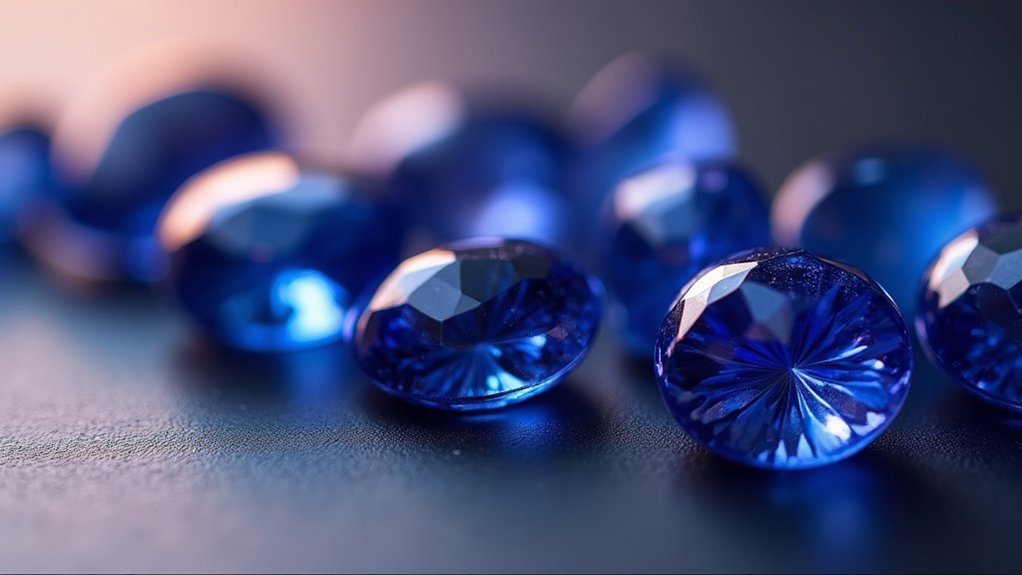
Here’s what affects pricing:
- Heat-treated tanzanite ranges from $100-$800 per carat, maintaining consistent value regardless of the treatment process.
- Untreated specimens typically cost two to three times more than heated stones of comparable quality.
- Premium unheated tanzanite with exceptional color can exceed standard pricing ranges considerably.
Since untreated tanzanite represents less than 1% of available gemstones, you’ll pay substantially more for these rare specimens, especially those with perfect natural color.
Identifying Pleochroism Quality in Enhanced Tanzanite
You’ll notice enhanced tanzanite’s pleochroism creates distinct color shifts as you rotate the stone, typically revealing blue, violet, and red flashes.
The viewing angle dramatically affects which colors appear most prominent, so you must examine the stone from multiple positions under proper lighting.
Strong pleochroic effects with vivid blue-violet saturation and noticeable red flashes indicate higher-quality enhanced tanzanite that commands premium prices.
Pleochroic Color Shifts
When you examine heat-treated tanzanite under proper lighting conditions, you’ll notice that the most valuable specimens display distinct pleochroic color shifts that reveal vivid blue and violet hues from different viewing angles.
The pleochroism becomes more pronounced after heat treatment, eliminating unwanted yellow or brown undertones that diminish value.
Quality pleochroic shifts you should look for include:
- Strong blue changes – Premium stones shift from deep blue in color to vibrant violet with clear distinction between hues.
- Minimal muddy tones – High-grade specimens show pure color shifts without brown or yellow interference.
- Saturated intensity – Top-quality tanzanite displays rich, vivid pleochroism rather than weak color changes.
Exceptional pleochroism combined with superior color and clarity greatly increases market value, especially when certified by reputable gemological laboratories.
Viewing Angle Effects
How dramatically does viewing angle affect your ability to identify quality pleochroism in heat-treated tanzanite? The answer lies in understanding that ideal positioning reveals the stone’s true potential.
You’ll notice the most pronounced color variations when rotating the tanzanite slowly under consistent lighting. Heat-treated stones typically display enhanced blue and violet tones from certain angles while minimizing unwanted brown hues from others.
Focus on finding the viewing angle that maximizes color depth and saturation. Quality enhanced tanzanite will show distinct pleochroism shifts as you tilt the stone, revealing vibrant blues evolving to rich violets.
Poor-quality stones lack this dramatic transformation. You’re looking for stones that demonstrate clear, pronounced color changes rather than muddy or indistinct variations when viewed from different positions.
Grading Heat-Treated Tanzanite Using Professional Standards
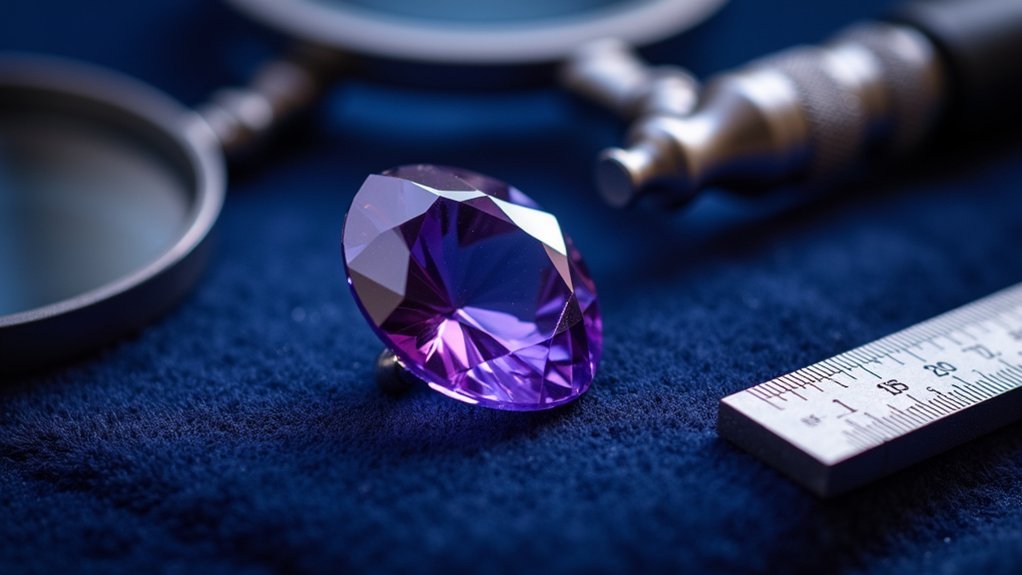
Although heat treatment transforms tanzanite’s appearance, the grading process remains unchanged from natural stones.
You’ll find that heat-treated tanzanite follows the same professional standards using the 4 Cs: color, clarity, carat, and cut.
Heat treatment doesn’t magically upgrade your stone’s classification. Medium-grade tanzanite stays medium-grade after heating.
However, understanding these grading factors helps you make informed purchasing decisions:
- Color grading focuses on rich violetish-blue hues with strong saturation—the most valuable tanzanite characteristic.
- Clarity assessment prioritizes eye-clean stones, as inclusions still impact visual appeal regardless of treatment.
- Professional evaluation considers all factors together, not just the enhanced color from heating.
Recognizing Signs of Proper vs. Poor Heat Treatment
What distinguishes expertly heat-treated tanzanite from poorly processed stones?
You’ll notice proper heat treatment eliminates unwanted yellow and brown hues, revealing vibrant blue or violet colors. Well-treated stones display even color distribution without patches or banding that indicate poor processing.
Check the intensity—quality heat treatment produces deep, saturated colors while poor treatment leaves stones pale or weak. Your blue gemstone should show no visible yellow undertones if properly heated.
Examine pleochroism carefully. Well-treated tanzanite exhibits strong pleochroic colors of blue and violet when viewed from different angles. Poorly treated stones reveal muted or mixed colors instead of distinct pleochroism.
Look for consistent coloration throughout the stone. Uneven areas or residual unwanted colors signal inadequate heat treatment that reduces your tanzanite’s value considerably.
Calculating Long-Term Value Appreciation Potential
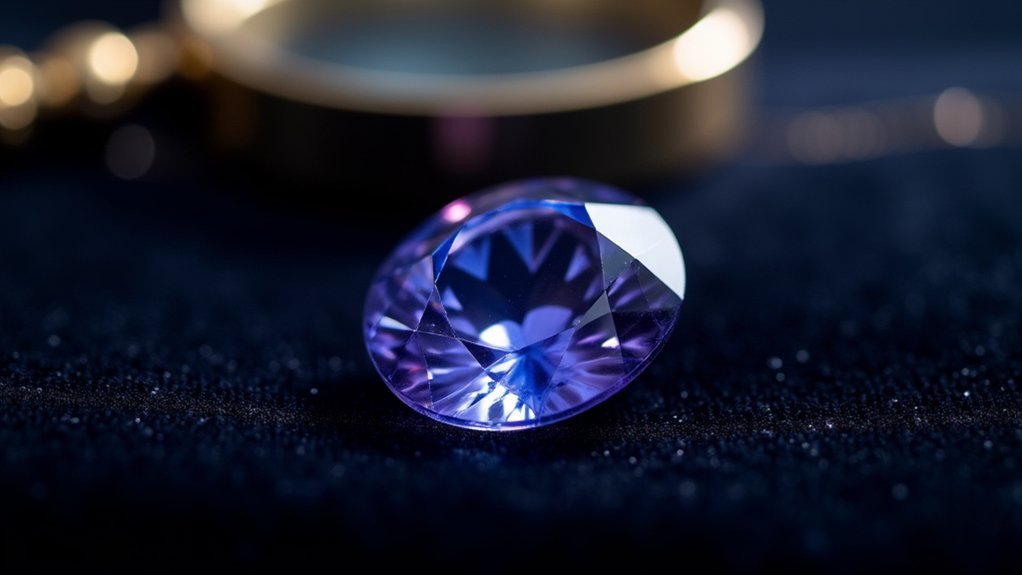
When evaluating heat-treated tanzanite’s investment potential, you’re looking at a gemstone with compelling scarcity dynamics that could drive significant appreciation.
With only 25 years of mining left at current extraction rates, tanzanite’s rarity positions it uniquely in today’s market.
Tanzanite’s finite 25-year mining timeline creates unprecedented scarcity that fundamentally distinguishes it from other gemstones in the luxury market.
Key factors that determine valuable tanzanite’s long-term potential include:
- Quality characteristics – Color saturation and clarity remain paramount, with richer hues and minimal inclusions commanding higher returns.
- Market timing – Recent 20%-30% price drops from smuggling and pandemic impacts create favorable entry points.
- Consumer awareness growth – Rising recognition of tanzanite’s uniqueness and limited availability drives demand.
Heat-treated stones experience minimal depreciation since treatment acceptance is widespread.
As scarcity intensifies and awareness grows, well-graded heat-treated tanzanite offers strong appreciation prospects.
Frequently Asked Questions
Is Heat Treated Tanzanite Valuable?
Heat-treated tanzanite retains its value based on the 4 Cs. You’ll find medium-grade stones maintain their worth, while top-grade pieces become more vibrant. However, you’ll pay more for rarer untreated stones.
How to Tell if Tanzanite Is Heat Treated?
You can’t definitively determine if tanzanite’s heat-treated since there aren’t scientific tests available. Look for primarily blue-violet colors without yellow or brown undertones, which typically indicates heat treatment.
How to Tell High Quality Tanzanite?
You’ll recognize high-quality tanzanite by its rich violetish-blue color with strong saturation, eye-clean clarity, excellent cut that maximizes brilliance, and verified Mount Kilimanjaro origin, especially in larger carat weights.
How to Appraise Tanzanite?
You’ll need to evaluate tanzanite’s color intensity, clarity grade, cut precision, and carat weight. Check for vivid blues or purples, minimal inclusions, excellent proportions, and verify heat treatment documentation to determine accurate market value.
In Summary
You’ll maximize your tanzanite investment by mastering these assessment techniques. Don’t overlook the interplay between heat treatment quality and natural characteristics when evaluating stones. You’re now equipped to identify superior color saturation, ideal clarity standards, and professional grading criteria. Remember that proper heat treatment enhances value rather than diminishes it. Apply these strategies consistently, and you’ll confidently navigate the tanzanite market while building a collection with strong appreciation potential.

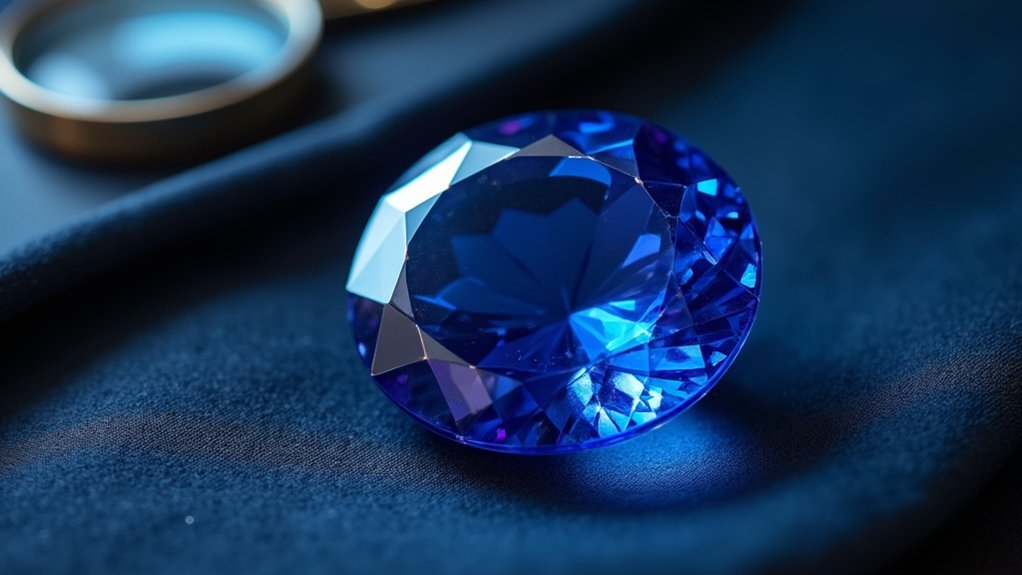



Leave a Reply